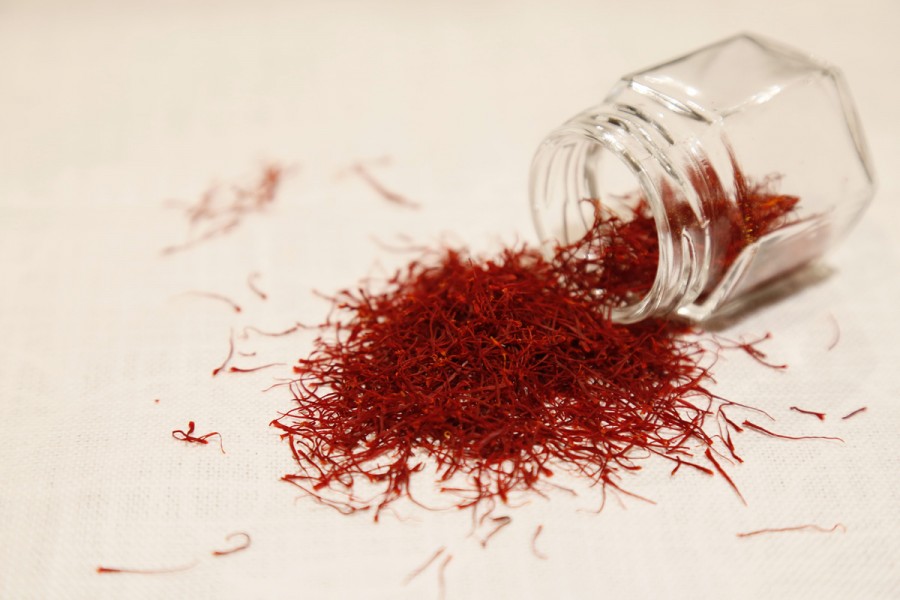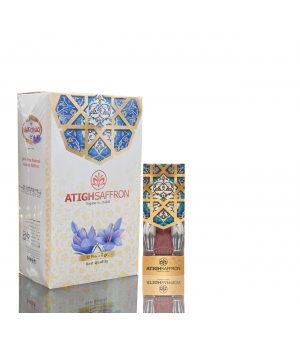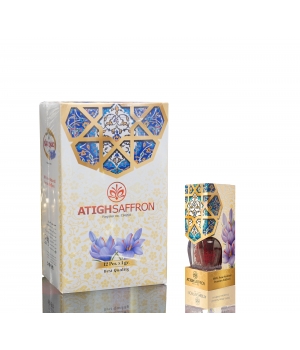Hippocrates, who is regarded as the father of medicine, wrote that saffron can effectively combat insomnia, stomach issues, cold, cough, flatulence, uterine bleeding, and heart-related ailments.Modern research also supports the claimed benefits of saffron. Keep reading to learn more about them and how saffron can improve your health!
What Are The Health Benefits Of Saffron?
The two major carotenoids in saffron, crocin, and crocetin may have antitumor effects. These compounds may also reduce inflammation risk. Safranal, another compound in the spice, was found to promote retinal health.
- May Reduce Cancer Risk
Saffron is rich in two major carotenoids, namely crocin, and crocetin. Preclinical evidence demonstrates that certain carotenoids may have potent antitumor effects .
Literature data indicate that saffron could be used as a potential cancer chemopreventive agent. Even though some of the data looks convincing, more well-designed clinical trials in humans are warranted to ascertain the anticancer effects of saffron .
As per another report, though the exact mechanism of the anticancer effects of saffron is unclear, its carotenoids could play a role. More trials in humans are needed to arrive at a definite conclusion .
Saffron and its components have also been suggested as promising candidates for cancer prevention. Crocin, one of its compounds, was found to have high potency as a chemotherapeutic agent .
- May Help Fight Inflammation And Arthritis
An Italian study states that the crocetin in saffron promotes cerebral oxygenation in rats and positively acts in arthritis treatment. This effect could most likely be attributed to its antioxidant activity. However, these results have been obtained only in vitro or on laboratory animals and not yet on humans .
Extracts of petals of the saffron plant were also found to have chronic anti-inflammatory activity. This effect could be attributed to the presence of flavonoids, tannins, alkaloids, and saponins. However, the other chemical constituents of saffron and their mechanisms are yet to be investigated .
- May Boost Vision Health
In rat studies, safranal, a constituent of saffron, was found to delay retinal degeneration. The compound could also reduce rod and cone photoreceptor loss. These properties make safranal potentially useful for delaying retinal degeneration in retinal pathologies .
Saffron supplementation was also found to induce a mid-term, significant improvement in the retinal function in the case of age-related macular degeneration. However, more research is warranted with respect to saffron supplementation in clinical practice .
- May Help In Insomnia Treatment
In rat studies, the crocin in saffron was found to boost non-rapid eye movement sleep. Crocetin, the other carotenoid in saffron, could also increase the total time of non-REM sleep by as much as 50% .
Other clinical trials also indicate that saffron supplementation could help improve symptoms of depression in adults dealing with major depressive disorder. One of the symptoms, as per research, is insomnia. However, further long-term follow-ups are required before firm conclusions can be made in this regard .
- May Promote Brain Health
The antioxidant and anti-inflammatory properties of saffron extracts could imply its therapeutic potential for various issues of the nervous system. The spice interacts with the cholinergic and dopaminergic systems, which may have beneficial effects in the case of Alzheimer’s or Parkinson’s .
However, more investigations are needed to have a detailed perspective of saffron’s effects on the human nervous system.
Some accumulating evidence also suggests that crocin in saffron could play a role in cognition. In animal models, this carotenoid in saffron could attenuate memory disorders related to Alzheimer’s, cerebral injuries, and schizophrenia .
However, saffron’s potential efficacy in memory disorders related to traumatic brain injury and brain ischemia is yet to be investigated .
- May Promote Digestive Health
Most animal studies show saffron to exhibit antioxidant, anticancer, anti-inflammatory, and anti-hyperlipidemic effects in treating gastrointestinal disorders. However, the efficacy of the spice in treating human gastrointestinal issues is yet to be investigated and understood .
- May Heal Burn Wounds
One rat study links the possible wound healing properties of saffron to its antioxidant and anti-inflammatory activity. Saffron could significantly increase re-epithelialization in burn wounds, as compared to cream-treated wounds .
The study raises the possibility of the potential efficacy of saffron in accelerating wound healing in burn injuries.
- May Enhance Immunity
Saffron is rich in carotenoids that seem to impact immunity. A study done on healthy men showed that daily use of saffron (about 100 mg) could have temporary immunomodulatory effects without any adverse reactions .
- May Offer Relief From Menstrual Symptoms
A herbal drug containing saffron was found to offer relief to women with primary dysmenorrhea. The study concluded by stating the need for more clinical trials to determine the efficacy of the herbal drug .
- May Improve Heart Health
Saffron helps reduce the risk of heart disease by strengthening the circulatory system. The spice is rich in thiamin and riboflavin, and these promote a healthy heart and help prevent various cardiac issues .
Due to its antioxidant properties, saffron helps maintain healthy arteries and blood vessels. The spice’s anti-inflammatory properties also benefit the heart. The crocetin in the spice indirectly regulates blood cholesterol levels and reduces the severity of atherosclerosis .
Saffron may also be useful in treating hypertension, as per a rat study .
- May Protect The Liver
Some research suggests that saffron could be useful for patients dealing with liver metastasis. The carotenoids in saffron may help inhibit the production of reactive oxygen species. But further investigations with a much larger sample size are required to arrive at any conclusion .
The safranal in saffron may also protect the liver from the environmental toxins. But this finding hasn’t been verified yet by human clinical trials. Hence, further human studies are warranted .
- May Work As An Aphrodisiac
The crocin in saffron could improve sexual behavior in male rats. It could increase mounting frequency and erection frequency in the rats . However, the safranal in the spice did not exhibit any aphrodisiac effects.
Saffron was also found to be effective in improving sperm morphology and motility in infertile men. It wasn’t found to improve the sperm count, though. Further studies involving large sample sizes are needed to elucidate the potential role of saffron in treating male infertility .
In another study, crocin could improve some reproductive parameters in mice treated with nicotine. The study speculates that the antioxidant effects of saffron could have been a major reason behind this particular positive impact. Further studies are needed to define the spice’s exact mechanism of action .
How Does Saffron Help Your Skin?
Saffron offers protection to the skin, thanks to its photoprotective and moisturizing effects
- May Protect Skin From UV Radiation
Studies suggest that saffron could be used as a natural UV-absorbing agent. It contains flavonoid compounds like kaempherol and quercetin, which could be contributing in this regard .
Saffron’s photoprotective effects may also be due to its other phenolic compounds, such as tannic, gallic, caffeic, and ferulic acids. A few of these compounds are used as active ingredients in various sunscreens and skin lotions .
However, saffron doesn’t seem to have any special moisturizing effect.But be cautious of using saffron on your skin and be careful of the amount as saffron may cause the skin to turn yellow if used in excess .
- May Enhance Complexion
We do not recommend the use of any ingredient with the sole purpose of whitening one’s skin. But saffron has shown certain complexion promotion effects .
What Is The Nutritional Profile Of Saffron?
| Spices, Saffron | ||
| Serving Size: 1 teaspoon (0.7 g) | ||
| Nutrient | Amount | Unit |
|---|---|---|
| Water | 0.083 | g |
| Energy | 2.17 | kcal |
| Energy | 9.09 | kJ |
| Protein | 0.08 | g |
| Total lipid (fat) | 0.041 | g |
| Carbohydrate, by difference | 0.458 | g |
| Fiber, total dietary | 0.027 | g |
| Minerals | ||
| Calcium, Ca | 0.777 | mg |
| Iron, Fe | 0.078 | mg |
| Magnesium, Mg | 1.85 | mg |
| Phosphorus, P | 1.76 | mg |
| Potassium, K | 12.1 | mg |
| Sodium, Na | 1.04 | mg |
| Zinc, Zn | 0.008 | mg |
| Copper, Cu | 0.002 | mg |
| Manganese, Mn | 0.199 | mg |
| Selenium, Se | 0.039 | µg |
| Vitamins | ||
| Vitamin C, total ascorbic acid | 0.566 | mg |
| Thiamin | 0.001 | mg |
| Riboflavin | 0.002 | mg |
| Niacin | 0.01 | mg |
| Vitamin B-6 | 0.007 | mg |
| Folate, food | 0.651 | µg |
| Vitamin B-12 | 0 | µg |
| Vitamin A, RAE | 0.189 | µg |
| Retinol | 0 | µg |
| Vitamin A, IU | 3.71 | IU |
| Vitamin D (D2 + D3) | 0 | µg |
| Vitamin D | 0 | IU |
| Fatty acids | ||
| Fatty acids, total saturated | 0.011 | g |
| Fatty acids, total monounsaturated | 0.003 | g |
| Fatty acids, total polyunsaturated | 0.014 | g |
Saffron is a versatile spice, and you can use it in more ways than one. In the following section, we have discussed the different ways you can use it.
How To Use Saffron?
Saffron not only imparts a distinct flavor and aroma but also makes your dish look more presentable. Saffron can be used in thread or ground form, depending on the recipe. If you are using saffron to garnish your dish and wish to create a visual impression, you can use threads. On the other hand, if you want the saffron to blend with your dish such that it is not obvious to the eye, you should go for its powdered form.
The cooking tips given below will enable you to reap the maximum benefits from this magical spice:
You can prepare powdered saffron instead of buying it from a supplier. You can do this by grinding the saffron threads with a mortar and pestle. If you find it difficult to grind the threads due to the moisture content, add a pinch of sugar to them and then grind. This will make grinding easier without affecting your recipe.
You can make liquid saffron by adding 3 to 5 teaspoons of warm or boiling water to powdered saffron and allow it to infuse for 5 to 10 minutes. Store it in a jar for a few weeks and use it when needed. Liquid saffron can also be prepared with milk, vinegar, or wine instead of water. It is usually added to other ingredients towards the end of cooking to draw out the color and disperse the flavor throughout the dish.
You can also make saffron milk. You need 1 cup of boiled milk, a pinch of saffron, and 2 teaspoons of sugar (if needed). Add the sugar and saffron to boiled milk. This saffron milk tea can be a good addition to your regular routine.
Though it is easy to use saffron, it is important to know its dosage.
Saffron Dosage And Side Effects
Some research states that 10.5 grams of saffron a day can cause toxic side effects. These include headache, dizziness, and loss of appetite, weakness, and, in extreme cases, may also be harmful to the lungs and kidneys .
For pregnant women, the daily upper limit for saffron, as per some sources, is 5 grams . Taking saffron orally in large amounts during pregnancy can cause problems – it can lead to contractions of the uterus and miscarriage . There is insufficient information with respect to breastfeeding. Hence, avoid use and stay safe.
It is important to note that exposure to high levels of saffron could increase the miscarriage rate, as per studies done on female rats. Studies suggest the use of high dose saffron by pregnant women .





